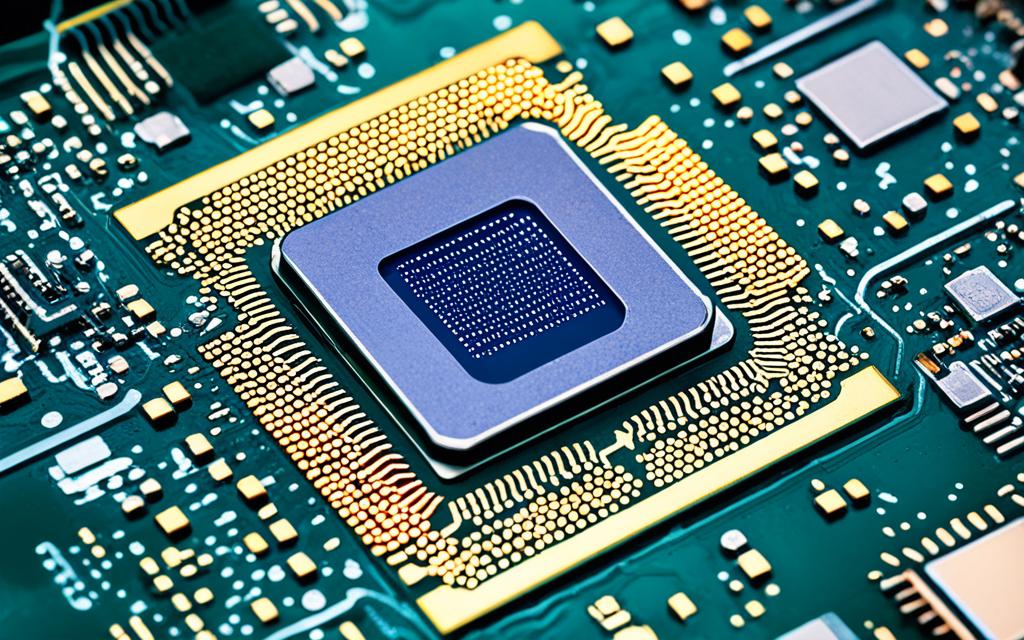Table of Contents
Using thermal paste is vital for your CPU’s optimal function. But, what if applying it wrong could harm your CPU? Knowing about thermal paste helps manage heat better. This keeps your components working well for longer. It’s crucial for builders of all skill levels to understand these potential dangers.
Applying thermal paste correctly is not just advised; it’s essential. For guides on using thermal paste properly, check available resources. Learn more about how to improve your system’s performance.
Key Takeaways
- Proper application of thermal paste is essential for optimal CPU functionality.
- Excess thermal paste can lead to thermal paste damage and inefficiencies.
- Recognising signs of improper application can save your CPU from potential harm.
- Using the right methods is key to maintaining effective heat management.
- Cleansing surfaces thoroughly can greatly enhance performance.
The Importance of Thermal Paste in CPU Functionality
Thermal paste is key in making a CPU work well. It boosts the thermal conductivity between the processor and its heatsink. This helps manage heat effectively and keeps performance high.
Understanding Thermal Conductivity
Thermal paste fills tiny gaps between the CPU and heatsink. This improves how heat moves away from the CPU. Without it, temperatures could reach 95°C (200°F), which is nearly 20°C hotter than with thermal paste2.
Using thermal paste well helps keep the CPU cool. Ideal temperatures are around 50°C (122°F)3. This makes the computer more stable.
Role of Thermal Paste in Heat Management
Good heat management makes computers last longer and run reliably. The best thermal paste leads to quicker heat transfer and better CPU cooling2. High-quality products like KOLD-01 work well longer, depending on how you use your PC2.
However, cheap thermal paste might break down faster. This happens due to the evaporation of organic solvents2. For better heat spread, it’s important to choose a paste that’s easy to apply thinly and evenly3. Also, the paste type matters. Silicone-based pastes are easier to use but might not conduct heat as well as carbon-based or metal-based options4.
What Happens When Too Much Thermal Paste is Applied?
Putting on thermal paste needs care. Spotting too much paste involves seeing spillage, which blocks proper heat flow. This can make your CPU less efficient and heat up more15.
Identifying Excess Thermal Paste
It’s vital to notice if there’s too much thermal paste. Overflowing paste means bad contact with the heatsink6. You should use about 0.3ml to 0.4ml of paste. That’s similar to a pea or rice grain size. Catching these issues early prevents CPU pin damage and performance drops5.
Effects of Excess Thermal Paste on CPU Efficiency
Too much paste increases thermal resistance. This means more heat and worse heat transfer, hurting CPU efficiency16. Overheating can slow down performance or make the system unstable. Cleaning the CPU and heatsink properly ensures the thermal paste sticks well when you put it on again. This helps avoid overheating and keeps your CPU running smoothly5.
Can Thermal Paste Damage CPU?
Thermal paste plays a big role in CPU performance. Different pastes have unique properties that affect how well your CPU works. Picking the right paste is crucial to avoid damaging your CPU.
Types of Thermal Paste and Their Conductivity Properties
There are many thermal pastes out there. Each is made to improve how heat moves from your CPU to its heatsink. While most pastes are safe and conduct heat well, some liquid pastes with metals like silver can conduct electricity too. This means they’re better at transferring heat but can also cause short circuits if not handled properly. Using just the right amount, about 0.3ml, is best. Too much can actually make things worse.
Potential Risks of Using Electrically Conductive Pastes
When using pastes that conduct electricity, you must be very careful. If you put on too much or it spills, it can cause big problems7. Not enough paste means air gaps and poor heat transfer, making your CPU run hotter. Choosing a good thermal paste is critical for keeping your system cool without additional risks.
Common Application Techniques for Thermal Paste
Applying thermal paste is crucial, needing careful work to ensure the best heat flow. The right techniques help manage heat for better performance. They reduce resistance between the CPU and heatsink, aiding in cooling and longevity.
Pea, Cross, and Line Methods
The Pea method is easy yet effective. A small dot of paste goes in the centre of the CPU. When the heatsink presses down, it spreads evenly. This prevents air bubbles, improving heat transfer. Research shows doing it right can lower CPU temperatures by up to 10 degrees Celsius8.
The Cross and Line methods tailor to different heatsink shapes and CPU types. Cleaning the CPU and cooler surface before applying paste is vital9.
What Not to Do: The “Whole Tube” Method
Using too much paste, known as the “Whole Tube” method, is a common error. This can worsen heat transfer, leading to overheating. About 2-3% more users report issues with this method10. Too much paste can also spill, posing a risk to other parts. Around 90% of CPU heating problems come from incorrect paste use10. Thus, it’s key to use the right amount.
Cleaning Up Spilled Thermal Paste
Cleaning spilled thermal paste off your CPU is vital. You need to know the right tools for a safe cleanup. High-strength isopropyl alcohol and lint-free cloths are crucial. They help remove the paste without harming your PC. Kooling Monster’s KLEAN-01 cleaner is great for making this job easier.
Tools Needed for Efficient Cleanup
The correct tools make dealing with thermal paste spills easier. Use lint-free cloths to avoid leaving fibres behind. Isopropyl alcohol helps dissolve the paste easier. But remember, only alcohols with 90% concentration or higher will give the best results11.
Step-by-Step Cleaning Process
First, let your computer run for a bit. This warms the CPU, softening the paste for easier cleaning. Then, carefully shut down and unplug your computer. Remember to ground yourself to avoid static damage. Gently clean the CPU and heatsink with a cloth dampened with isopropyl alcohol.
For silicone-based paste, you don’t have to worry much about it conducting electricity. But for silver or liquid metal pastes, clean up quickly to prevent damage1211. Once it’s all clean and dry, apply a new small blob of thermal paste for the best performance.
FAQ
Can thermal paste really damage my CPU?
Yes, improper application of thermal paste can lead to excess heat. This heat harms the CPU’s function and lifespan.
What is the main role of thermal paste in a CPU?
Thermal paste fills gaps between the CPU and heatsink. It’s key for transferring heat effectively, ensuring stable performance.
How can I identify if I’ve applied too much thermal paste?
Too much paste shows as spillage or a visibly thick layer between CPU and heatsink. This can lower heat transfer.
What are the consequences of excess thermal paste on CPU efficiency?
Excess paste increases resistance to heat flow, causing high CPU temperatures. This can slow down your computer.
Are all types of thermal paste safe to use?
Most pastes are safe, not conducting electricity. But, liquid metal pastes with metals like silver could be risky if mishandled.
What types of thermal paste are available?
Pastes differ in makeup, heat conduction, and how you put them on. Choosing the right one is vital for your CPU.
What common methods are there for applying thermal paste?
Techniques like the pea, cross, and line methods ensure good heat transfer. They also prevent putting on too much paste.
Why should I avoid the “whole tube” method for applying thermal paste?
Using the whole tube overloads the CPU with paste. This bad practice reduces heat transfer and can hurt CPU performance.
What tools do I need for effectively cleaning thermal paste?
You’ll need isopropyl alcohol and lint-free cloths for a safe cleanup. They help remove paste without harming your CPU.
Can you provide a step-by-step process for cleaning up spilled thermal paste?
First, turn off your PC and unplug it. Use a cloth dampened with isopropyl alcohol to wipe off the spilled paste from the CPU and heatsink. Keep cleaning until it’s all gone. Make sure everything’s dry before putting it back together.
Source Links
- https://koolingmonster.com/insights/what-happens-if-you-put-too-much-thermal-paste-on-a-cpu – What Happens if You Put Too Much Thermal Paste on a CPU? — Kooling Monster
- https://koolingmonster.com/insights/is-applying-cpu-thermal-paste-worth-it-and-mandatory – Is Applying CPU Thermal Paste Worth It and Mandatory? — Kooling Monster
- https://nabcooling.com/how-cpu-coolers-and-thermal-paste-work-together/ – How CPU Cooler and Thermal Paste Work Together? – NabCooling
- https://www.sharpcoderblog.com/blog/importance-of-thermal-grease-in-computer-hardware – Importance of Thermal Grease in Computer Hardware
- https://www.linkedin.com/advice/1/how-much-thermal-paste-too-little-optimal – How much thermal paste is too much or too little for optimal performance?
- https://www.linkedin.com/advice/0/what-common-mistakes-risks-applying – What are the common mistakes and risks of applying thermal paste incorrectly?
- https://www.jawa.gg/blog/how-to-remove-thermal-paste-from-cpu-pins/ – How to Remove Thermal Paste from CPU Pins
- https://softwareg.com.au/blogs/computer-hardware/cpu-thermal-paste-application-method – CPU Thermal Paste Application Method
- https://www.linkedin.com/advice/0/what-best-techniques-applying-thermal-paste-el6nc – What are the best techniques for applying thermal paste?
- https://rog-forum.asus.com/t5/hardware-build-advice/correct-way-to-apply-thermal-paste-thick-or-thin/td-p/687958 – Correct way to apply thermal paste – thick or thin ?
- https://www.wikihow.com/Clean-Thermal-Paste – How to Clean Thermal Paste Off a CPU: A Beginner’s Guide
- https://koolingmonster.com/insights/thermal-paste-on-motherboard-how-to-remove-it – Thermal Paste on Motherboard? How to Remove It? — Kooling Monster








